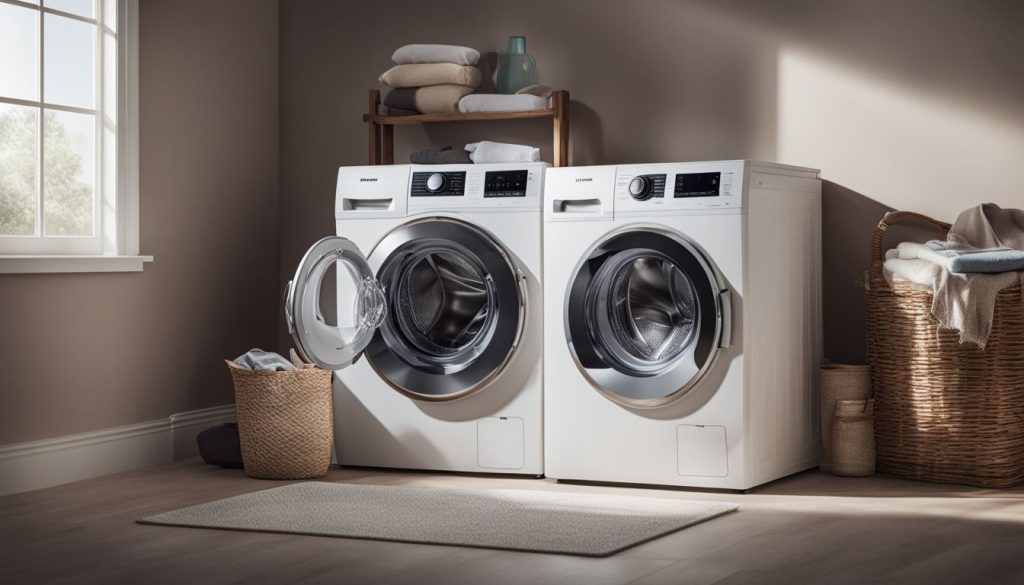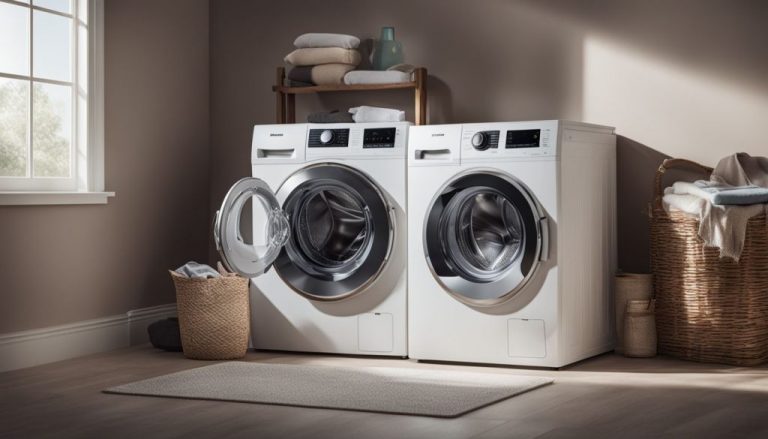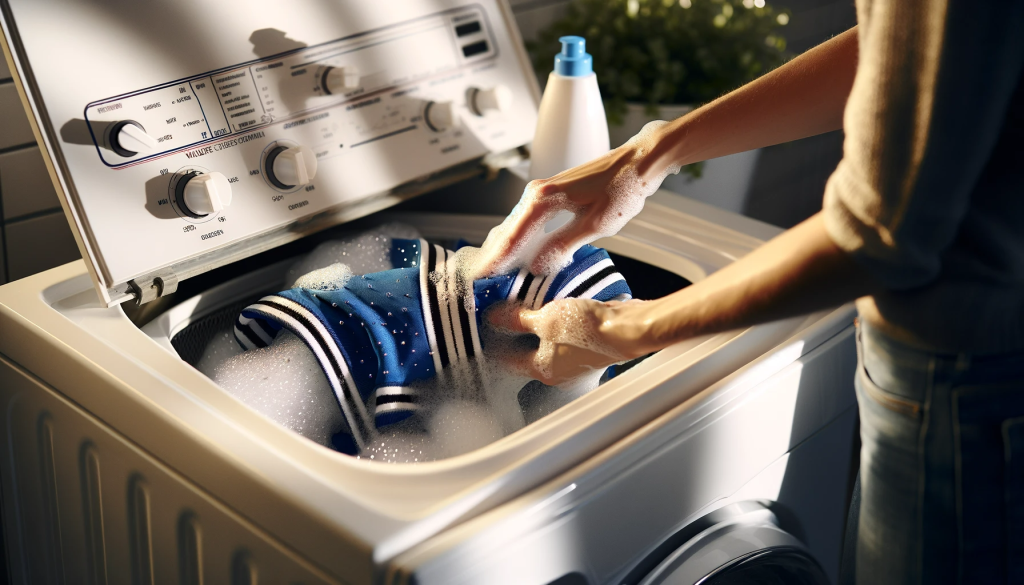Are you ready to revolutionize your laundry routine and protect your favorite outfits? This guide shatters common laundry myths and equips you with the knowledge to keep your clothes looking fresh and fabulous. For stylish apparel that withstands the test of time, check out InktasticMerch and ensure your wardrobe remains a masterpiece.
On laundry day, many people find themselves fretting over the dos and don’ts of caring for their clothes. Surprisingly, some widespread beliefs about laundry are simply myths. Our guide dispels these misconceptions, offering you accurate information to help extend the lifespan of your garments.
Get ready to become a laundry aficionado!
Key Takeaways
- Employing improper stain removal techniques can cause permanent marks, so it’s essential to treat stains according to specific needs and fabric instructions.
- Regularly clean your washing machine by wiping it down and occasionally running a deep clean cycle to prevent mold and odors, ensuring more thorough cleaning.
- Adding more detergent doesn’t equate to cleaner clothes; the right amount prevents residue buildup and ensures genuine cleanliness.
- Use hot water sparingly, as it risks fading colors and shrinking materials; adhere to care labels for temperature advice.
- Excess dryer sheets can leave a waxy coating, diminishing towel absorbency; stick to the recommended quantity per load size.
Common Laundry Myths
There are prevalent myths suggesting that a single stain removal method works for all, that washing machines never need cleaning, and that more detergent results in cleaner clothes.
We’re here to dispel these myths and present the truths behind effective laundry practices.
All Stains Can be Removed by One Method
Believing that a single treatment can tackle all stains is a myth that might do more harm than good. Stains adhere to fabrics in different ways, and incorrect interventions can make them permanent.
For instance, oil-based stains require a different approach than protein-based ones like blood or sweat. Identifying the stain type before selecting a suitable cleaning method is crucial.
Grease marks often call for a degreaser, whereas organic stains may benefit from enzyme-based cleaners.
The type of fabric also influences stain removal strategies. Delicate fabrics such as silk or wool need more gentle handling than sturdier materials like cotton or synthetics. Proper pretreatment is key; applying a specialized remover prior to washing can greatly aid in lifting stubborn stains.
Temperature is another critical factor; some stains dissolve better in cold water, while others respond to hot temperatures. Always refer to garment labels for guidance on temperature and substance-specific instructions, ensuring your clothes remain in top condition without unnecessary guesswork.
You Don’t Need to Clean Your Washing Machine
Your washing machine works tirelessly to clean your clothes, and it too needs occasional attention. Over time, soap residue, fabric softeners, and moist clothes create a prime environment for mold and unpleasant odors.
By cleaning your machine, you ensure it operates efficiently and keeps your clothes smelling fresh.
Make a habit of wiping the drum, gasket, and detergent dispensers regularly. For a more thorough clean, run an empty cycle with hot water and vinegar or a specialized cleaner every few months.
This simple maintenance routine not only extends the life of your washing machine but also leads to better results with each wash.
More Detergent Means Cleaner Clothes
Addling extra detergent may seem like a shortcut to cleaner clothes, yet it is a prevalent myth. Overloading with detergent can actually cause buildup on fabrics and inside the machine, opposing the goal of cleanliness.
Clothes simply need the right amount of detergent, not excessive suds, to come out truly clean.
Using the correct quantity of detergent, as advised by the manufacturer, is key to achieving optimal cleaning outcomes. Exceeding the recommended amount doesn’t boost cleaning efficacy; in reality, it can encapsulate dirt within fabric fibers, as surplus suds cushion rather than remove grime.
Reevaluate your clothing care habits and consider reducing detergent use if you’ve been overzealous in your measurements. This straightforward adjustment can prolong the life of your clothing and ensure a thorough clean for each item.
Accurate detergent measurement promotes efficient cleaning without leaving behind sticky residues that can dull colors and attract more dirt over time. Maintaining detergent levels as prescribed is essential for effective laundry practices that protect both your clothes and the performance of your washing machine.
Hotter Water Equals Better Cleaning
While hot water can aid in removing grease and oil stains from heavily soiled items, it is not universally necessary for all loads. Overuse of hot water may cause colors to fade and fabrics to shrink.
For optimal results, consider fabric type and stain characteristics before choosing a wash temperature. By paying attention to clothing care labels, you can select between cold, warm, or hot water settings to fit specific laundry requirements.
More Dryer Sheets Equal Better Results
Greater use of dryer sheets does not necessarily lead to superior outcomes. The quantity of dryer sheets should be adjusted to the load size and desired level of softness and static control.
Using too many dryer sheets can leave a waxy coating on clothing, diminishing their absorbency and breathability. Follow manufacturer guidelines to achieve the best results.
Correct use ensures garments emerge from the dryer feeling soft, without cling or residual chemicals. Excessive use is unwarranted and can even negatively impact your laundry, so adhering to recommendations is advisable for optimum outcomes.
Hand Soaps Can Clean Clothes Just as Well
It’s important to note that hand soaps may not be as effective at removing dirt and stains, lacking the specialized components of laundry detergents.
Due to their pH levels and surfactants, hand soaps are not tailored for fabric cleaning, potentially leading to residue buildup and dulled garments over time.
Knowing how to use laundry detergent appropriately is vital for keeping clothes clean. Adhering to care label directions and using the correct amount of detergent ensures effective cleaning without harming fabric or causing residue accumulation.
Debunking Myth and Revealing Facts

Ensuring your washing machine is properly cleaned is crucial for its performance and durability. Correct detergent use and sorting laundry according to care labels can greatly help in maintaining the quality of your garments.
Appropriate Ways to Clean Your Washing Machine
To keep your washing machine pristine, follow these guidelines:
- Regularly wipe the door seal and drum after each use to curb mold and mildew.
- Perform a cleaning cycle with a washing machine cleaner monthly to remove bacteria and odors.
Proper Detergent Usage
Accurately measure the detergent based on the load size and soil level to prevent inefficiencies. Using too much or too little can compromise cleaning performance.
Adhere to the manufacturer’s specifications for your particular washing machine and fabric type to achieve the best results.
Select a detergent that suits the fabric type of your clothing. Different textiles demand specific detergents, so choose one that aligns with your laundry requirements. Always review labels and instructions to comprehend proper usage and dosing to avoid damaging your clothing or machine.
The Truth About Washing Underwear
Shifting from detergent use, it’s crucial to comprehend the facts about washing underwear. Many assume that hot water is necessary for cleaning undergarments effectively.
However, using hot water can deteriorate the elastic and lead to premature wear and tear of the fabric.
To maintain the integrity of your underwear, wash them in cold or warm water with a gentle detergent, protecting delicate lace or embellishments on your lingerie.
The Right Amount of Dryer Sheets
Focusing on the efficiency of dryer sheets, it’s important to understand that more doesn’t always mean better. Too many sheets can leave a waxy residue and diminish the absorbency of towels.
Typically, one or two sheets suffice for standard-sized loads. Overuse can also block the lint trap, leading to restricted airflow and prolonged drying times.
Follow the manufacturer’s directions and consider your preferences to find the optimal number of dryer sheets per load.
Properly Sorting Laundry
Accurate laundry sorting is pivotal for maintaining garment quality and ensuring efficient cleaning:
- Segregate whites, darks, and colors to avoid color transfer.
- Distinguish delicate fabrics like silk and lace from sturdy items like jeans or towels to prevent damage.
- Review garment care labels for washing instructions before sorting.
- Wash heavily soiled garments separately to prevent dirt transfer.
- Avoid mixing lint-emitting fabrics with those that attract lint to minimize fuzz.
The Proper Temperature for Different Types of Stains
Cold water is ideal for protein-based stains like blood or sweat, preventing them from setting. Hot water dissolves oily stains, effectively removing grease. For color-safe bleachable stains, such as coffee or tea, choose warm water to break down stain compounds without harming fabrics.
Applying the correct temperature for various stains is key to their removal. Cold water works for protein stains, hot water suits oily marks, and warm water is best for color-safe bleach stains.
Using the Right Amount of Detergent
Determining the appropriate detergent amount is vital for pristine and fresh-smelling laundry. Excess detergent can result in residue, while insufficient amounts may fail to eliminate stains and odors.
Understanding the right amount helps maintain optimal cleanliness.the correct quantity, check the detergent packaging for guidelines tailored to load size and soil level. Adhering to these recommendations ensures efficient cleaning without harming fabrics or causing skin irritation.
Accurately measuring and distributing detergent not only minimizes waste and conserves this vital laundry resource but also proves cost-effective over time. Using the prescribed amount of detergent yields cleaner clothes while supporting sustainability through mindful usage.
Additional Laundry Tips
Washing bras properly can enhance their longevity and preserve their shape. Sorting clothes according to the care label and adhering to washing and drying instructions are crucial steps in preventing damage.
Sorting Clothes by Care Label
When organizing laundry, always examine the care label on each garment.
- Consult the care labels on clothing for specific washing directives.
- Arrange items by the suggested washing temperature, whether it be cold, warm, or hot water.
- Divide garments based on the care label’s recommendations for drying methods, such as tumble drying, line drying, or laying flat.
- Group clothing by the specified detergent type; for instance, regular detergent or delicate detergent.
- Take note of any special care instructions indicated on the label, like handwashing or dry cleaning only.
- Follow any additional care details provided on the label to preserve fabric quality and color endurance.
- Utilize these labeled instructions as an essential resource for maintaining and extending the lifespan of your clothing.
The Importance of Following Care Label Instructions
Adhering to care label instructions is vital for preserving the quality and extending the life of your clothing. These labels offer critical details on how to wash and dry different fabrics, helping you avoid damage.
By following these guidelines, your garments are kept cleaner and their color and fabric integrity are protected.
Grasping the specific care requirements for each item also enables a more efficient sorting process. This prevents color bleeding and ensures delicate materials are washed with the correct settings.
Properly Washing Bras
For maintaining bra quality, it is essential to hand wash them in cold water using a gentle detergent. Avoiding bleach and fabric softeners is important as these can deteriorate the fine fabrics and elasticity.
After washing, gently press out excess moisture and lay them flat on a towel to air dry; avoid wringing them or using a dryer. Following these guidelines will help ensure your bras last longer and retain their condition.
It’s essential to note that the longevity of your intimate wear begins with proper washing techniques. By following these straightforward guidelines, you ensure they remain in good condition for extended periods, ultimately saving money and ensuring optimal hygiene and comfort.
Dealing With Stains
Proper bra washing is pivotal for maintaining quality. When tackling stains, employ these strategies to remove them effectively and keep your clothes pristine:
- Dab the stain promptly to prevent it from setting in.
- Directly apply a stain remover or detergent to the stain and gently rub the fabric together.
- For obstinate stains, pre-soak the garment in a solution of water and stain remover before proceeding with washing.
- Refer to the care label for specific instructions about treating that fabric type.
- Wash garments with stains, adhering to the guidance provided by the care label for the best results.
items individually to prevent stain transfer or damage to other garments.
Avoiding Overloading the Washer
Piling too many clothes into the washer can lead to them being less clean. The machine requires ample room for water and detergent to circulate effectively around the clothes. Moreover, cramming in numerous garments can place undue stress on the machine during the spin cycle.
When overloaded, clothes might not rinse thoroughly or could wear out more quickly. Excessive loading might also cause imbalanced loads, resulting in loud banging noises during washing, which may indicate potential harm to both your apparel and the washing machine.
If you wish to keep your clothes well-cleaned and undamaged, be mindful of not overcrowding your washer.
Conclusion – Laundry Myths and Facts
To wrap up, distinguishing between laundry myths and facts is vital for preserving the cleanliness and care of your clothing. Proper upkeep of your washing machine and correct detergent application play a significant role in prolonging the lifespan of your clothes.
By adhering to care label guidelines for sorting laundry and promptly addressing stains, you can help maintain fabric integrity. Embracing these laundry best practices will keep your clothes looking fresh and vibrant for an extended time.
FAQs
1. Why is it important to separate laundry?
Separating laundry helps prevent color bleeding and ensures each type of fabric receives the right washing method.
2. Can I wash all colors together in one load?
No, it’s advisable to separate light and dark clothing to prevent color transfer during washing.
3. Do I need to hand-wash delicates separately from other items?
Yes, items like lace, silk, or lingerie should be either hand-washed or placed in a mesh laundry bag when washing with other garments.
4. Is it necessary to sort laundry based on fabric type?
Yes, sorting laundry by fabric type (such as cotton or synthetics) guarantees that each material is treated to the appropriate water temperature and level of agitation during washing.
5. Should I always follow garment care labels when separating laundry?
Yes, adhering to garment care labels is crucial as they provide specific laundering instructions tailored to each item’s fabric and construction needs.
To further enhance your laundry skills and explore more insightful articles, visit our Blog for a wealth of knowledge on fabric care and maintenance.




